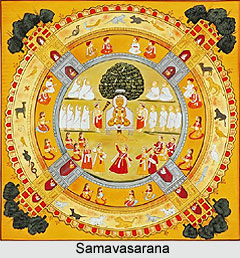 Samavasarana is a Jain term used for referring to the divine preaching hall or the assembly of the Jain Tirthankaras. It is used once they have attained the perfect knowledge or Kevala Jnana. It is also known by the term Samosarana. The religious congregation of the Tirthankaras is known as Samavasarana. Here sermons and speeches are delivered by them.
Samavasarana is a Jain term used for referring to the divine preaching hall or the assembly of the Jain Tirthankaras. It is used once they have attained the perfect knowledge or Kevala Jnana. It is also known by the term Samosarana. The religious congregation of the Tirthankaras is known as Samavasarana. Here sermons and speeches are delivered by them.
During Samavasarana many devotees from far off places assemble to hear the preaching of the Jain gurus. The concept of Samavasarana has been a popular theme for Jain art. During Samavasarana there is happiness all around. The sermon is imparted to many animals and a vast throng of heavenly gods, ascetics and lay people. While the Tirthankara delivers his sermons sitting on a soft cushion, soft music is played. He speaks in a language is understandable to all. As per Jain doctrines earlier the Tirthankara used to deliver sermons in the local language of the people, which was Ardha Magadhi Prakrit. The voice of the Tirthankara is very melodious and is thus very soothing to hear. It is believed that all those who attend the Samavasarana and hear the speeches become less violent and greedy.
During the sermon a Tirthankar always faces the East direction but the heavenly gods create three replicas of him. He thus faces three other directions. This is done to enable the heavenly beings, humans and animals to see and hear the Tirthankara.
Style of Samavasarana
The Samavasaran is a four-layered circular structure with a sacred Ashoka tree at its centre. The first layer is reserved for the Tirthankara and his Ganadharas, or disciples. It has a cushion where the Tirthankara would sit and is shaded by a tree that is almost twelve times the height of the Tirthankara. The second layer is meant for the human beings while the third are for the animals. The lower or the fourth layer most enclosure serves as a parking ground for the conveyances of heavenly beings and human beings. The hall should measure 12 km and must have gates enclosing all the sides of the hall. Thius Samavasarana is constructed for a Tirthankar`s sermon soon after he attains Keval Gyan.



















